Welcome to another captivating article on my website, this time highlighting the wonders of my hometown, Patteeswaram. Every trip I embark on is a well-thought-out plan. I would say it’s a blessing to be able to carve out itineraries that bestows upon several benefits. I don’t just choose a destination randomly; instead, I focus on the significance of the place to help me make my decision. It is this instinctive longing that has always influenced my choice of travel destinations. One recent example is my visit to several significant temples in and around Kumbakonam. This feature is a continuation of my previous article on the ancient temples around Kumbakonam. If you haven’t had a chance to explore that yet, I highly recommend checking it out either before or after reading this article. Here’s the link.
Kumbakonam and Patteswaram both hold a unique place in my heart, not simply because they were the destinations of my childhood summer vacations at my grandparents’ home, but due to their spiritual importance.
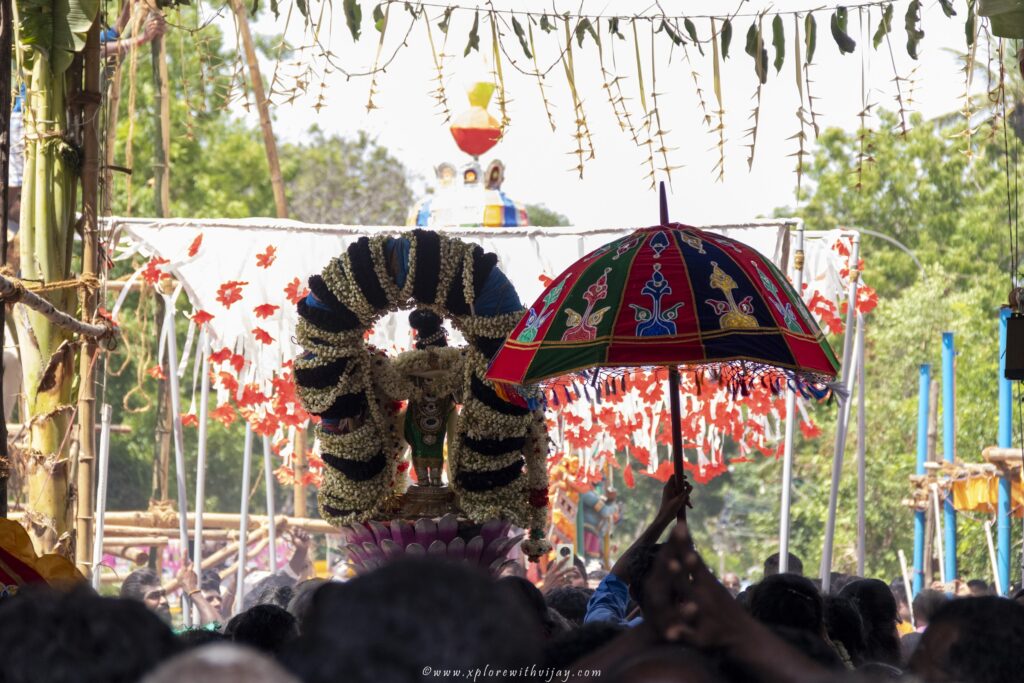
Patteeswaram, a village situated just 8 km from Kumbakonam in Tamil Nadu, is renowned for its historically and religiously significant temples, namely the Dheenupureeswarar Temple and the Kothandaramaswamy Temple. The Dheenupureeswarar Temple, dedicated to Lord Shiva, is intricately linked with the legend of Saivite poet Sambandar. On the other hand, at the Kothandaramaswamy Temple, Lord Rama is said to have relieved of one of the doshas caused by killing of Ravana. He installed Shiva Lingam at the Dheenupureeswarar temple and invoked the blessings of Lord Shiva to liberate himself from the Chaya Hathi dosham. Later, on the request of Devas, Lord Rama graced the temple with a divine appearance in a Kalyana Kolam. Another legend associated with the Kothandaramaswamy temple is that of sage Shaliar, known as Pattu Shalia Maharishi. Pattu in Tamil means Silk. The major activity of the population in Patteeswaram is related to silk yarn and weaving. Sage Shaliar was in the silk weaving trade. Silk weavers always bore a dosha as they had to kill numerous silkworms in their profession. The Sage wanted to protect them from dosha. Hence, he performed a penance at the Kothandaramaswamy temple. The lord granted pardon from the sin to the community. He also prayed to Lord Rama to stay in this place itself so that the weavers could worship him daily. Lord granted the boons sought by the Rishi (Sage) and stayed here.
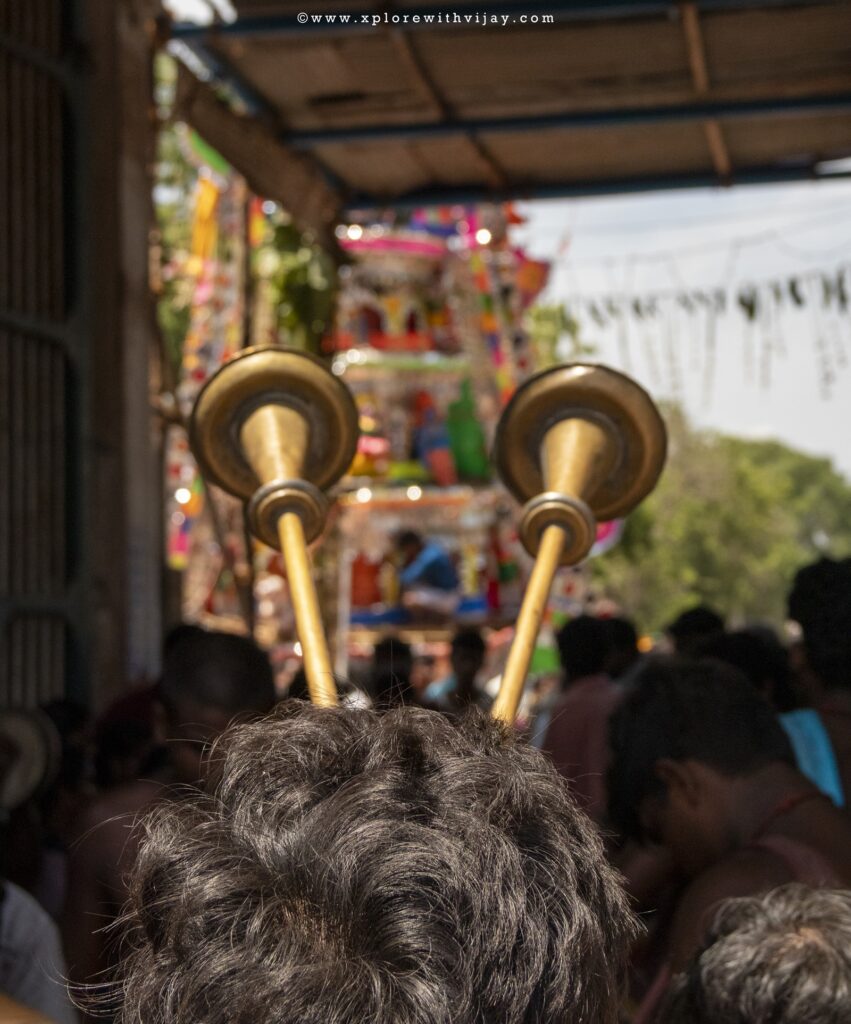
Muthu Pallaku Festival: The Grand Entry of Saivite Poet, Thiru Jnana Sambandhar
The annual festival at the Dhenupureeswarar Temple is celebrated with great divinity and enthusiasm. To the best of my knowledge, this festival is one of a kind and showcases the diversity between Shaivism and Vaishnavism. I have grown up hearing numerous tales about this unique festival from my father and extended family members, but I never had the opportunity to experience it myself. However, in the recent past, we were blessed with the divine grace and were drawn to this important place of worship.
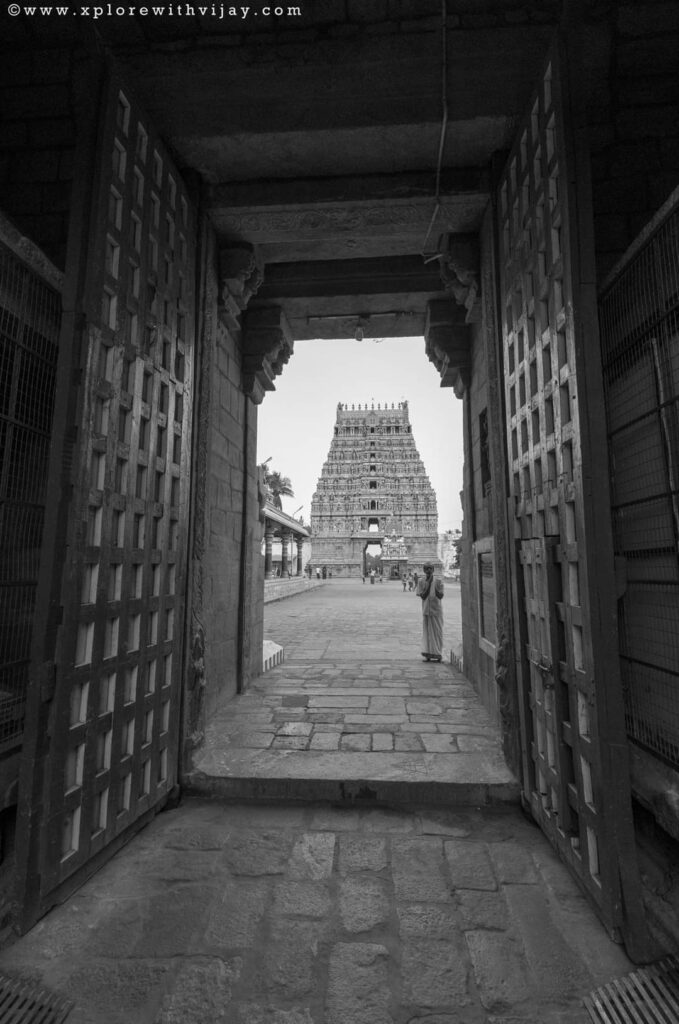
Every year, the beginning of Tamil month Aani marks the inception of this ancient annual festival at the Dhenupureeswarar temple in Patteeswaram, honoring & recreating the grand entry of the revered Saivite Poet Thiru Jnana Sambanthar. Centuries ago, the Saivite Poet, Thiru Jnana Sambandhar, completed his prayers at Thiru Sakthi Mutram (also known as Arulmigu Sakthivaneswarar Temple) and set out on a journey with his disciples to seek darshan of the Lord at Patteeswaram. As they embarked on their pilgrimage, a scorching heat wave swept through the region. Concerned for the wellbeing of the great poet, Lord Dhenupureeswarar instructed the Devas to carry a special designed Muthu Pallaku (literally translated as Pearl Palanquin or an Umbrella made with pearls) to shield him from the intense heat. To Thiru Jnana Sambanthar’s surprise, he found a beautiful ‘Flower Top’ providing much-needed relief from the blazing sun. Filled with awe as he gazed at the Lord from the temple entrance, Thiru Jnana Sambanthar uttered his first verse of praise for the Lord of Patteeswaram. Shiva instructed Nandi to step aside so that Sambandar could have a view of the sanctum sanctorum from the outside. The Nandi at this temple is situated in a unique position in relation to other Shiva temples, as it is not directly facing the sanctum sanctorum but rather positioned to the side. The festival of Muthu Pallaku is organized annually to commemorate this event, featuring legendary tales from the life of Thiru Jnana Sambanthar.

LEGEND OF SAMBANDAR:
Sambandhar’s remarkable upbringing as an enlightened child is an extraordinary tale. Born through a boon granted to a pious Brahmin named Sivapada Hridayar and his virtuous wife, Bhagavathiar, Sambandhar was no ordinary child. It is said that Mother Parvathi herself fondled Sambanthar and fed him with the milk of divine wisdom, resulting in his transformation into Thiru-jnana-sambandar, meaning one who attained divine wisdom through the grace of Lord Siva and Parvathi. This divine awakening led Sambandhar to compose soul-stirring songs in praise of Lord Siva, which are collectively known as Thevaaram.
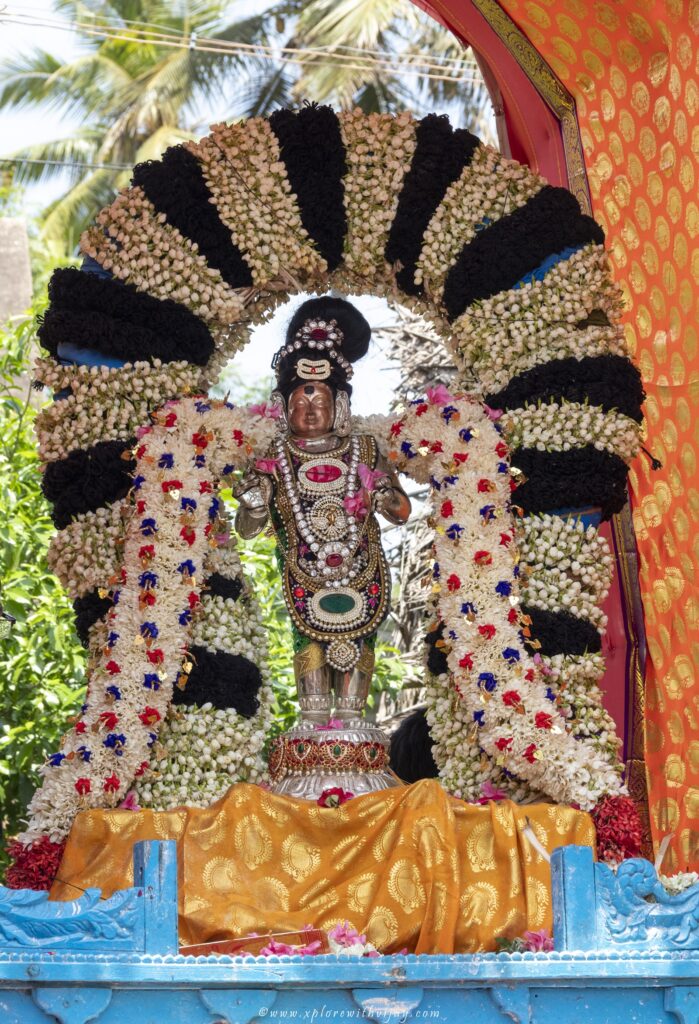
Reimagining the Legendary Event
The annual procession of Thiru Jnana Sambandhar is a grand and ceremonial event that holds deep cultural and religious significance. The procession begins as Thiru Jnana Sambandhar emerges from the Dhenupureeswarar temple on a Pearl Palanquin, carried by several Sri Patham Thangis. The procession is a sight to behold as the Pearl Palanquin is carried by several Sri Patham Thangis through the streets surrounding the temple. The entourage makes a brief stop at the Sabhali Nayaki Sametha Kailasanatha Temple in Thenampadugai village. This temple, dedicated to Sabhali, Kamadenu’s daughter, holds great historical and religious importance. The journey continues to the Thiru Sakthi Mutram (also known as Arulmigu Sakthivaneswarar Temple) in Patteswaram, with a visit to the Kothandaramaswamy Temple along the way.
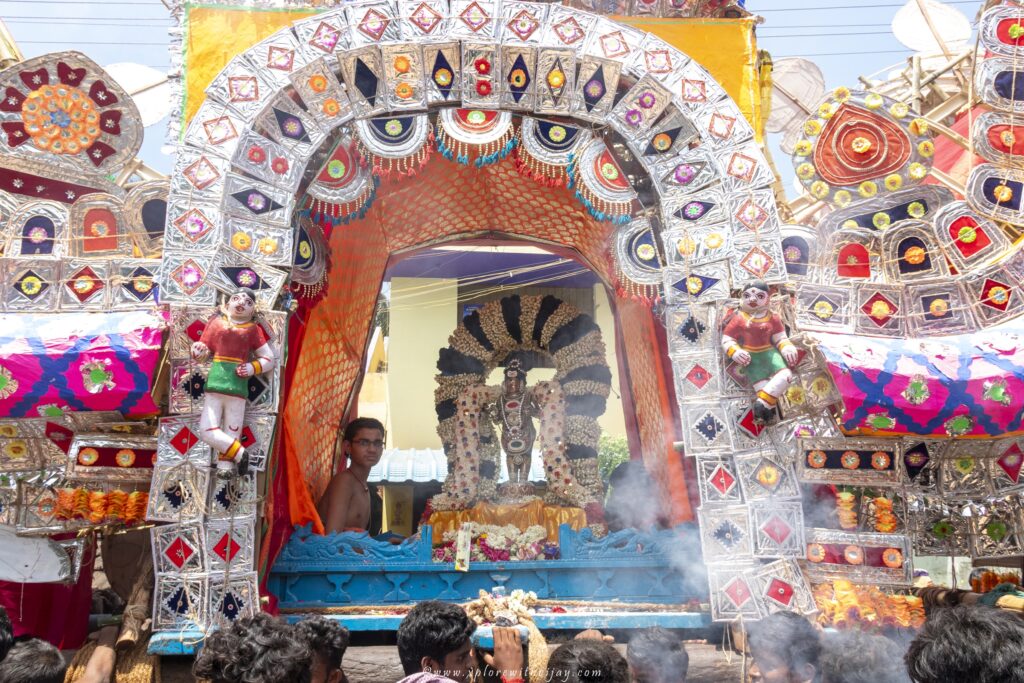
One of the most striking aspects of the festival is the blending of traditions, as Thiru Jnana Sambandhar visits the Kothandaramaswamy Temple and receives a divine Silk Shawl, symbolizing the coexistence of Shaivism and Vaishnavism in the village.
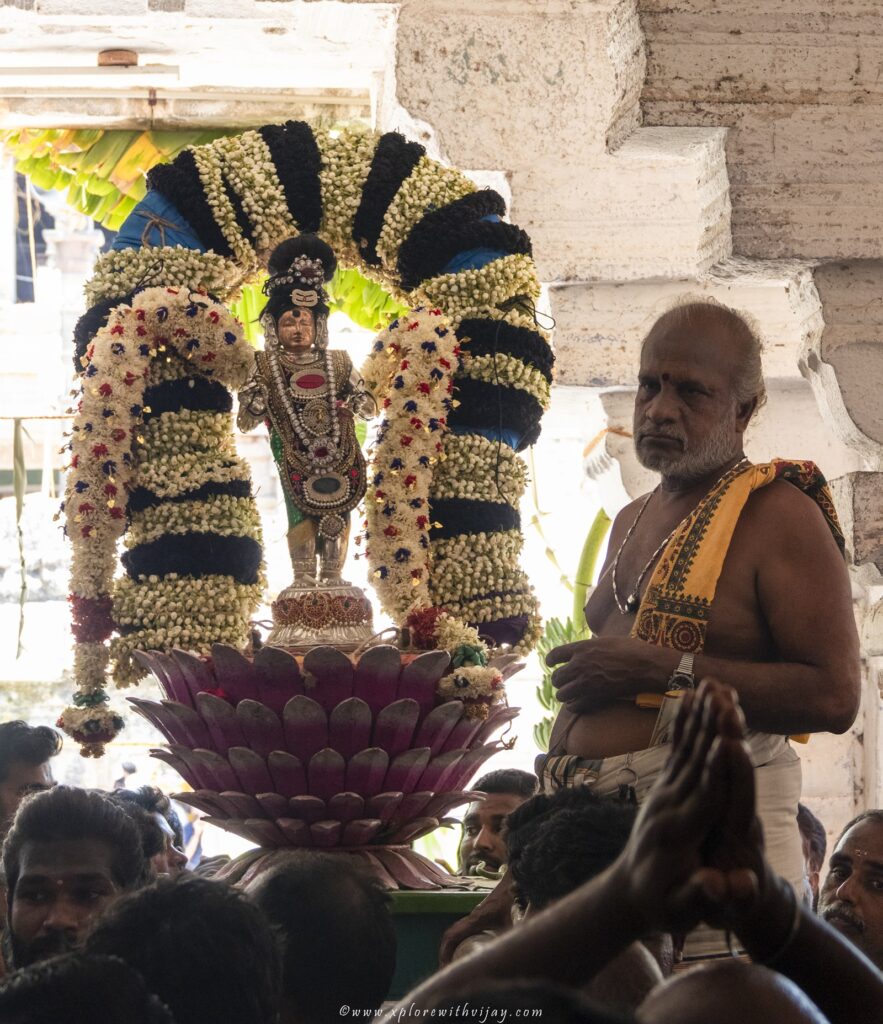
As the ceremonious procession arrives at Arulmigu Sakthivaneswarar Temple and the rituals begin, the sun is at its blazing peak and the heat is relentless. The heat of the afternoon during the rituals at Arulmigu Sakthivaneswarar Temple adds to the atmosphere, reminiscent of the hot days over a thousand years ago when these traditions began.
As dusk falls, the joint darshan provided by Thiru Jnana Sambanthar and Lord Dhenupureeswarar with a procession around the streets of Patteeswaram marks the culmination of this unique and vibrant festival. The sense of devotion and the blend of ancient rituals and modern-day celebrations truly make the ‘Pearl’ Festival an unforgettable experience.
LINKS:
If you enjoy social media, you can see my photos by clicking on the links below:
Instagram: https://www.instagram.com/xplore_with_vijay/
YouTube: https://www.youtube.com/@xplore_with_vijay/
Facebook: https://www.facebook.com/vijay8686
I trust that you enjoyed the virtual travel experience with me. Please share your feedback in the comments below. Feel free to share this with your family and friends. Remember to subscribe to my travelogues for early access to captivating travel content. Looking forward to seeing your comments.

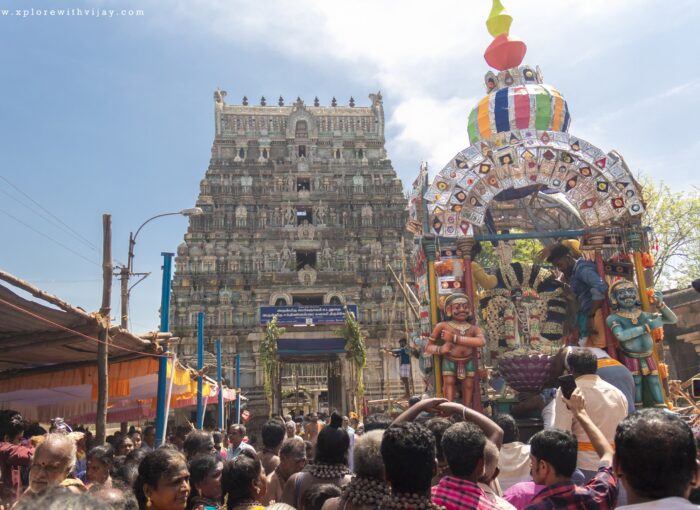
Beautifully described the history of Patteeswaram and the significance of the Muthu Pallaki festival.
I am glad that you enjoyed reading this articulation!
Very nicely elaborated all the details. Muthu Pallaku is very nice. Thanks for sharing. I heard but did not hv a chance to go during that time. But you have brought to me like seeing IN person. Glad. God bless you to show us more and more pictures like this. 🙂
Thank you so much, Usha. I am grateful for your kind words. It was truly a blessing to experience the festive atmosphere and observe the various rituals.
Yes, certainly! I will continue to publish more such articles through the medium of this website. Do share this article with your family and friends!